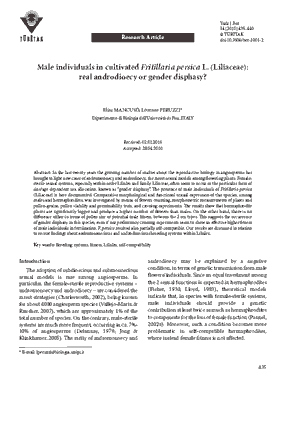NEWS 2010
Male individuals in cultivated Fritillaria persica L. (Liliaceae): real androdioecy or gender disphasy
Elisa MANCUSO, Lorenzo PERUZZI
Turkish Journal of Botany, 34: 435 – 440 (2010)
doi:10.3906/bot-1001-2
Dipartimento di Biologia dell'Università di Pisa, ITALY
Abstract
In the last twenty years the growing number of studies about the reproductive biology in angiosperms has brought to light new cases of andromonoecy and androdioecy, the rarest sexual models among flowering plants. Femalesterile sexual systems, especially within order Liliales and family Liliaceae, often seem to occur in the particular form of size/age dependent sex allocation, known as “gender disphasy”. The presence of male individuals of Fritillaria persica (Liliaceae) is here documented. Comparative morphological and functional sexual expression of this species, among males and hermaphrodites, was investigated by means of flowers counting, morphometric measurements of plants and pollen-grains, pollen viability and germinability tests, and crossing experiments. The results show that hermaphrodite plants are significantly bigger and produce a higher number of flowers than males. On the other hand, there is no difference either in terms of pollen size or potential male fitness, between the 2 sex types. This suggests the occurrence of gender disphasy in this species, even if our preliminary crossing experiments seem to show an effective higher fitness of male individuals in fertilization. F. persica resulted also partially self-compatible. Our results are discussed in relation to recent findings about andromonoecious and androdioecious breeding systems within Liliales.

